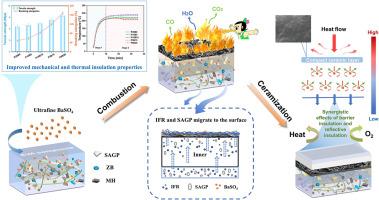超细硫酸钡(BaSO4)对提高高填充EVA复合材料力学性能、陶瓷化性能和保温性能的影响
IF 7.4
2区 化学
Q1 POLYMER SCIENCE
引用次数: 0
摘要
传统的高填充(70%)聚合物复合材料由于机械性能、可加工性和热防护性能差,在综合应用中受到限制。本文采用超细硫酸钡(BaSO₄)提高了高填充EVA复合材料的这些性能,同时保持了平衡的阻燃性。其中,添加10 wt%的超细硫酸钡可使复合材料的抗拉强度、断裂伸长率和熔体流动率分别提高11.75%、78.63%和63.46%。硫酸钡颗粒良好的分散性促进了界面润滑和相容性,显著提高了机械性能和加工性能。在模拟火灾条件下对其耐火性能和保温性能进行了评价。结果表明,硅铝玻璃粉(SAGP)和硫酸钡(BaSO₄)有利于在表面形成连续致密的陶瓷层。烧蚀35 min后,P10B10的背面温度仅为207.55℃,比P20B0低34℃,表明P10B10具有良好的绝热性,且温升延迟。P10B10陶瓷渣的压缩模量达到7.27 MPa。陶化和热机制表明,SAGP/BaSO₄协同作用使多层功能化,实现了屏障和反射隔热的结合。在加热过程中,共熔硼酸锌(ZB)和SAGP向受热表面迁移和聚集,与硫酸钡氧化物形成共晶相,包括硅酸铝钡(BaAl2SiO6)、硅酸锌钡(BaZnSiO4)和硼酸钡(BaB2O4)结晶相。基于氧化物的陶瓷层有效地阻挡了热量和氧气的渗透。此外,在多孔炭层中均匀分布的硫酸钡延长了传热路径和反射热量,增加了热损失,保持了内部材料的完整性。这项工作证明了超细硫酸钡在增强高填充聚合物复合材料中的作用,为开发高性能阻燃和陶化复合材料提供了新的策略。本文章由计算机程序翻译,如有差异,请以英文原文为准。

Effect of ultrafine barium sulfate (BaSO4) on improving the mechanical properties, ceramifiable and thermal insulation performance of highly filled EVA composites
Traditional highly filled (70 %) polymer composites are limited in comprehensive applications by poor mechanical properties, processability, and thermal protection. Herein, ultrafine barium sulfate (BaSO₄) was used to enhance these properties of highly filled EVA composites while maintaining balanced flame retardancy. Specifically, adding 10 wt% ultrafine BaSO₄ increased the tensile strength, elongation at break, and melt flow rate of the composites by 11.75 %, 78.63 %, and 63.46 %, respectively. The excellent dispersibility of BaSO₄ particles promoted interfacial lubrication and compatibility, significantly improving the mechanical properties and processability. Fire resistance and thermal insulation properties were evaluated under simulated fire conditions. The results showed that silica-aluminum glass powder (SAGP) and BaSO₄ facilitated the formation of a continuous and dense ceramic layer on the surface. After 35 min of ablation, P10B10 exhibited a backside temperature of only 207.55 °C, 34 °C lower than P20B0, indicating excellent thermal insulation with a delayed temperature rise. Ceramic residues of P10B10 reached a compressive modulus of 7.27 MPa. Ceramization and thermal mechanisms revealed that SAGP/BaSO₄ synergistically enabled the multi-layer functionalization, achieving combined barrier and reflective heat insulation. During heating, co-melt zinc borate (ZB) and SAGP migrated and aggregated towards the heated surface, forming eutectic phases with barium sulfate oxides, including barium aluminum silicate (BaAl2SiO6), barium zinc silicate (BaZnSiO4) and barium borate (BaB2O4) crystalline phases. The oxide-based ceramic layer effectively blocked heat and oxygen penetration. Additionally, uniformly distributed BaSO₄ in the porous char layer extended heat transfer paths and reflected heat, increasing heat loss and preserving internal material integrity. This work demonstrates the role of ultrafine BaSO₄ in enhancing highly filled polymer composites and provides a novel strategy for developing high-performance flame-retardant and ceramizable composites.
求助全文
通过发布文献求助,成功后即可免费获取论文全文。
去求助
来源期刊

Polymer Degradation and Stability
化学-高分子科学
CiteScore
10.10
自引率
10.20%
发文量
325
审稿时长
23 days
期刊介绍:
Polymer Degradation and Stability deals with the degradation reactions and their control which are a major preoccupation of practitioners of the many and diverse aspects of modern polymer technology.
Deteriorative reactions occur during processing, when polymers are subjected to heat, oxygen and mechanical stress, and during the useful life of the materials when oxygen and sunlight are the most important degradative agencies. In more specialised applications, degradation may be induced by high energy radiation, ozone, atmospheric pollutants, mechanical stress, biological action, hydrolysis and many other influences. The mechanisms of these reactions and stabilisation processes must be understood if the technology and application of polymers are to continue to advance. The reporting of investigations of this kind is therefore a major function of this journal.
However there are also new developments in polymer technology in which degradation processes find positive applications. For example, photodegradable plastics are now available, the recycling of polymeric products will become increasingly important, degradation and combustion studies are involved in the definition of the fire hazards which are associated with polymeric materials and the microelectronics industry is vitally dependent upon polymer degradation in the manufacture of its circuitry. Polymer properties may also be improved by processes like curing and grafting, the chemistry of which can be closely related to that which causes physical deterioration in other circumstances.
 求助内容:
求助内容: 应助结果提醒方式:
应助结果提醒方式:


